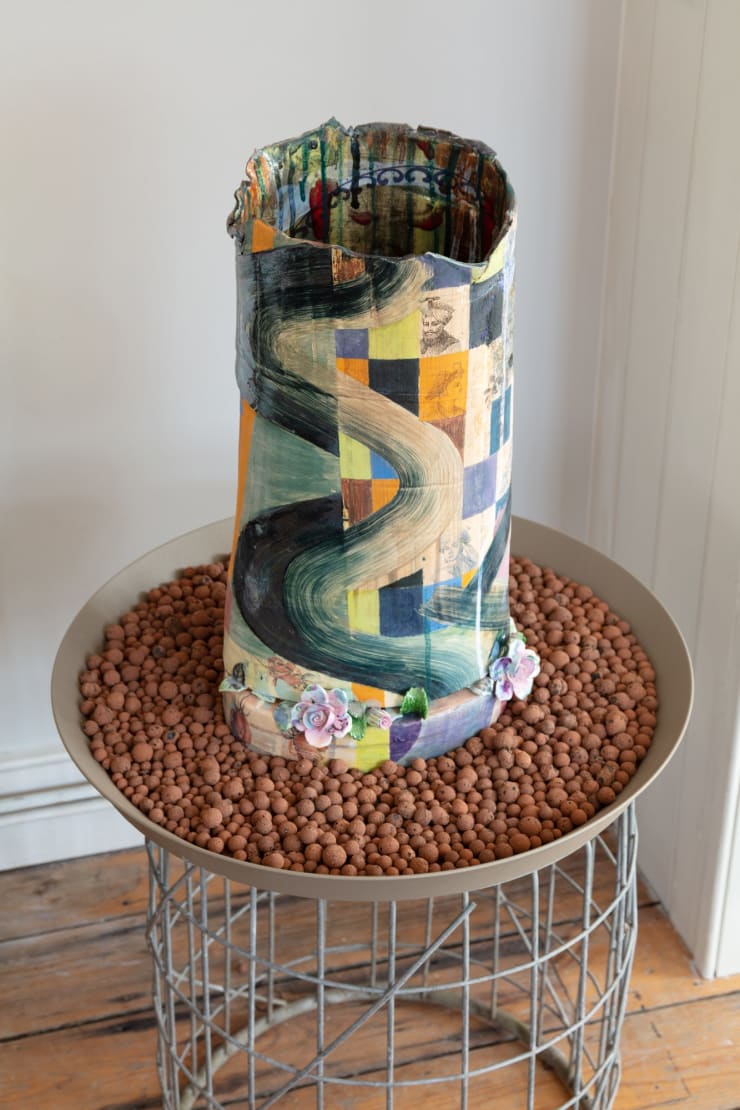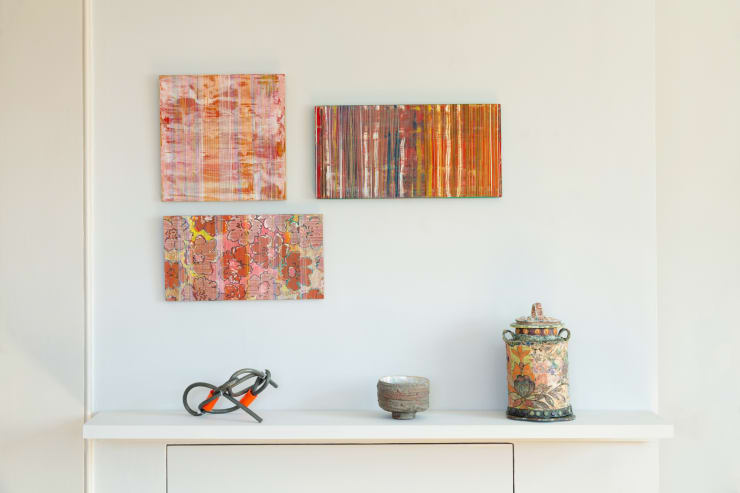HAPPENSTANCE: Robert Cooper
Ceramics & sculpture
Until May 25th
In association with London Craft Week
Venue: 155A Lordship Lane, East Dulwich, London SE22 8HX
Teasing, finicking, making
We can think of fragments as witnesses to, and tellers of disparate histories. Strewn across time and laid bare, they speak of other lives, other places. Art historian Linda Nochlin proposes that the fragment embodies the often disconnected, and disintegrative effects of modern experience. She considers the shard, the offcut, the splinter, the part-object to be potent signifiers. Since the French Revolution, she writes, artists have exploited the disorderliness and tenacity of unrelated fragments, ‘joining [them] up […] in a pictorial totality where the very arbitrariness of the cuts and joints emphasizes the artfulness of the project as a whole.’ (1)
The fragments that make up Robert Cooper’s candlesticks are similarly disorienting and potent. Thick green glass. Bottle necks. Clay detritus from the workbench. Broken figurines. Soft-paste porcelain. Jug handles. Trinkets. Pipe stems. Bin ends of glaze. Discontinued ceramic transfers. Moorish tiles. There is, at the same time, a perfect synchrony to this rabble of things, often discovered while mudlarking on the Thames foreshore. Robert’s pieces are a judicious combination of past and present – not streamlined or rational, but rather off-key. It is the discord between these fragments, these histories-in-pieces, that sings. Robert’s candlesticks are time-and-space travellers: splintered and whole, knowing and unknowable, they exhibit, in his words, ‘the persistence of the obsolete in our solar-powered present.’ (2)
Robert describes the diurnal qualities of his candlesticks. Each one is a diary utterance, a record not only of the act of making, but also of the accumulated histories that wash up on the Thames foreshore. His candlesticks, assembled from these finds, speak of multiple times and in multiple tongues. A Victorian salt-glazed stoneware inkwell forms the base of one, while the rust accretions on an unidentified metal fragment form its stem. The capital, which holds the candle in place, is fashioned from fragments of glass (a thick green-glass bottle stem and clear-glass bottle lip), and the candlestick is completed with a greyhound handle from a Georgian Staffordshire relief-moulded beer jug, only slightly discoloured and still in sharp relief. What results is a suture of historic styles that shows playful irreverence for design-historical decorum.
Much like Irish poet Louis MacNeice’s tenacious candlestick-maker, with his ‘Squeezing, teasing, finicking, faking / Bothering, soldering, doddering, making’(3), Robert continually assembles and re-assembles, drawing attention to the potency of fragments, their being-there-ness as well as their perpetual incompleteness. Yet, unlike the candlestick maker who often worked with metal casting or spinning, Robert’s methods are more akin to that of an itinerant cobbler, who reworked, or ‘cobbled together’ new shoes from old leather (4). The candlesticks are pasted together using Japanese resin, their junctures visible and rough. This to emphasise the mismatch of parts, as well as their unconformity. This method has an affinity with the Japanese technique of kintsugi that uses urushi (Japanese lacquer) dusted with powdered gold to celebrate the event of a breakage, often significantly increasing the value of the original ceramic piece (5). Robert’s candlesticks are joined with resin to simulate and restore the essence of their original artefact-ness. Yet while kintsugi is about a near-perfect reconstruction, the candlesticks are wilfully disjointed. There is also a fluency to them that comes from an acute knowledge of materials and their histories, as well as a fascination with the wider visual environment. Robert has been making candlesticks, on-and-off, since the 1980s, and his restless invention is reflected in his kaleidoscopic assemblages – they are eclectic, jaunty, suggestive. While some come together quickly, others can take years, yet Robert offers all of these fragments the potential to be made whole again.
We can think of these candlesticks as timepieces that speak of the tides, of the making of London, its shipping, trade guilds, and crafts, of fashion and taste, of waste, value, and material histories. They are also imaginings, material fantasies that ask what if…? What if we gather together all these seductive fragments – the spout of a brown-glazed teapot, the rim of a Spode Blue Italian plate, a late-nineteenth century glass stopper – into a single form? Perhaps then we come closer to the essence, the what it is to be of a candlestick.
Text by Kimberley Chandler. Originally published in Teasing, finicking, making, a short monograph on Robert Cooper's work, with photography and design by Michael Harvey (Blurb, 2022). Reproduced with permission from the author.
-
 Robert CooperGiftedCeramic lidded vesselh.23.5 x 16 x 16cm£ 950.00
Robert CooperGiftedCeramic lidded vesselh.23.5 x 16 x 16cm£ 950.00 -
 Robert CooperGetting a Handle On ItCollage31.5 x 44.5cm£ 500.00
Robert CooperGetting a Handle On ItCollage31.5 x 44.5cm£ 500.00 -
 Robert CooperFlight PlanCollage27.5 x 38cm£ 450.00
Robert CooperFlight PlanCollage27.5 x 38cm£ 450.00 -
 Robert CooperModern LivingCollage27 x 43.5cm£ 450.00
Robert CooperModern LivingCollage27 x 43.5cm£ 450.00 -
 Robert CooperCouple, 2025Candlestick
Robert CooperCouple, 2025Candlestick
Reclaimed ceramic elementsL: 27.5 x 7 x 7cm
R: 27 x 12.5 x 9.5cm£ 1,400.00 -
 Robert CooperBig Wave, 2025Candlestick
Robert CooperBig Wave, 2025Candlestick
Reclaimed ceramic elements29.5 x 14.5 x 11.5cm£ 850.00 -
 Robert CooperMuch TriedCeramic
Robert CooperMuch TriedCeramic
Tea BowlH.8 x 11.5 x 9.5cm£ 650.00 -
 Robert CooperChequeredCeramic lidded vesselh.25 x 14 x 11.5cm£ 1,100.00
Robert CooperChequeredCeramic lidded vesselh.25 x 14 x 11.5cm£ 1,100.00 -
 Robert CooperBouquet, 2025Candlestick
Robert CooperBouquet, 2025Candlestick
Reclaimed ceramic elements33.5 x 9 x 8cm£ 800.00 -
 Robert CooperTime and Time AgainCeramich.44 x 21 x 21.5cm£ 2,800.00
Robert CooperTime and Time AgainCeramich.44 x 21 x 21.5cm£ 2,800.00 -
 Robert CooperOrange FindBicycle Lock12 x 22.5 x 14cm£ 420.00
Robert CooperOrange FindBicycle Lock12 x 22.5 x 14cm£ 420.00 -
 Robert CooperQuietCeramic
Robert CooperQuietCeramic
Tea Bowlh.9 x 12 x 9cm£ 700.00 -
 Robert CooperIntenseCeramic lidded vessel26 x 16 x 15cm£ 1,200.00
Robert CooperIntenseCeramic lidded vessel26 x 16 x 15cm£ 1,200.00 -
 Robert CooperSlip StreamCandlestick
Robert CooperSlip StreamCandlestick
Reclaimed ceramic elements29 x 9 x 8cm£ 800.00 -
 Robert CooperBluesCandlestick
Robert CooperBluesCandlestick
Reclaimed ceramic elements23 x 11 x 7cm£ 800.00 -
 Robert CooperSide SqueezeFramed paper collage23.5 x 26.5cm£ 600.00
Robert CooperSide SqueezeFramed paper collage23.5 x 26.5cm£ 600.00 -
 Robert CooperWall PieceCandlestick
Robert CooperWall PieceCandlestick
Reclaimed ceramic elements33 x 32 x 7cm£ 950.00
1 Linda Nochlin, The Body in Pieces: The Fragment as a Metaphor of Modernity (London: Thames and Hudson, 1994), p. 53.
2 Unless otherwise stated, all words in quotation marks are the artist’s own.
3 Louis MacNeice, ‘The Candlestick Maker’ (n.d.), republished in The Princeton University Library Chronicle,
Vol. 59, No. 3 (Spring 1998), pp. 411–412: p. 412.
4 Giorgio Riello, The Boot and Shoe Trades in London and Paris in the Long Eighteenth Century, PhD thesis, University College London, 2002.
5 Bonnie Kemske, The Teabowl: East and West (London: Bloomsbury, 2017), p. 65.






































